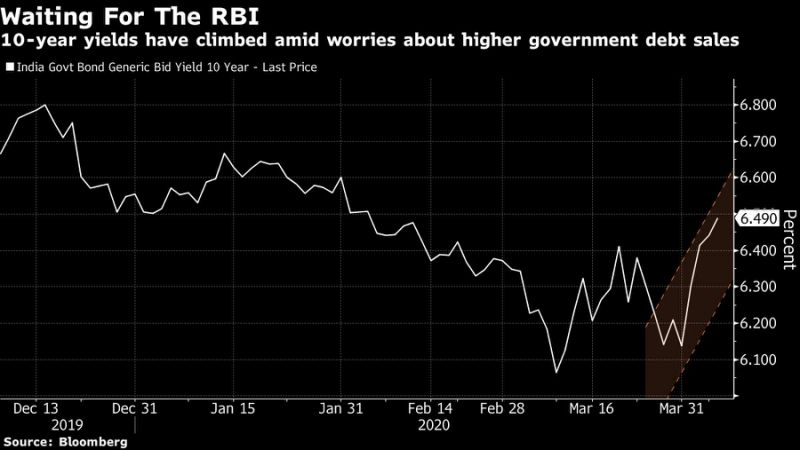
(Bloomberg) — When India kicked off its record-borrowing plan last week, traders were betting that the central bank would step in quickly to ease the debt burden. Governor Shaktikanta Das will make an unscheduled address on Friday just as another auction looms.
The government is slated to sell 200 billion rupees ($2.6 billion) of bonds. Its first auction of 190 billion rupees was unexpectedly fully subscribed as investors bought on expectations that the Reserve Bank of India would purchase more debt in the secondary market to cap rising yields.
“The RBI could take a leaf from other global central banks and announce an expanded bond purchase program, which would bring a much need succor to the markets,” said Prakash Sakpal, an economist at ING Groep NV in Singapore. Given the fiscal constraints, “the monetary policy needs to do all the heavy-lifting.”
READ: Australia Sells A$13 Billion Bonds in Biggest Sale on Record
India’s predicament is mirrored in other Asian markets, as governments compete for funding to combat a coronavirus-driven slowdown. While central banks in Australia and New Zealand have embarked on massive bond purchases, capping borrowing costs, the RBI has largely refrained from the measures.
As a result, India’s benchmark 10-year bond yield has climbed 30 basis points so far in April, set for its biggest monthly rise in two years.
Modi’s Debt Plans
The RBI didn’t disclose details of the governor’s address, which will be broadcast on YouTube at 10 a.m. local time.
The government is selling 450 billion rupees of debt, including Treasury bills, every week for the first half of the fiscal year to help fund Prime Minister Narendra Modi’s record borrowing plan of 4.88 trillion rupees during this period. The weekly debt issuance is about 20% higher than a year ago.
“Market participants are heavily banking on the RBI for their rescue,” said Dhawal Dalal, chief investment officer for fixed income at Mumbai-based Edelweiss Asset Management Ltd. “Any miscalculation by the RBI could result in a sudden increase in yields.”
Last week, the government had to pay underwriters almost 50 times more in fees for its first bond sale of the fiscal year, underscoring how nervous primary dealers were. The RBI executed a 75 basis points emergency rate cut last month, and also pledged to provide $50 billion of liquidity.
Attractive Yields
However, some traders are of the view that higher yields may attract some demand. The benchmark 10-year yield rose one basis point on Thursday to 6.44%. It had risen to 6.51% on April 9, the highest since February.
“After the recent sell-off, banks may be seeing a good value in the current level of yields,” said Debendra Dash, a Mumbai-based fixed-income trader at AU Small Finance Bank in Mumbai. “The 10-year yields are expected to stay around the current levels, and any sustainable rally will be guided by the RBI’s support.”
(Updates with economist comment in third paragraph)
<p class="canvas-atom canvas-text Mb(1.0em) Mb(0)–sm Mt(0.8em)–sm" type="text" content="For more articles like this, please visit us at bloomberg.com” data-reactid=”34″>For more articles like this, please visit us at bloomberg.com
<p class="canvas-atom canvas-text Mb(1.0em) Mb(0)–sm Mt(0.8em)–sm" type="text" content="Subscribe now to stay ahead with the most trusted business news source.” data-reactid=”35″>Subscribe now to stay ahead with the most trusted business news source.
©2020 Bloomberg L.P.











Add Comment